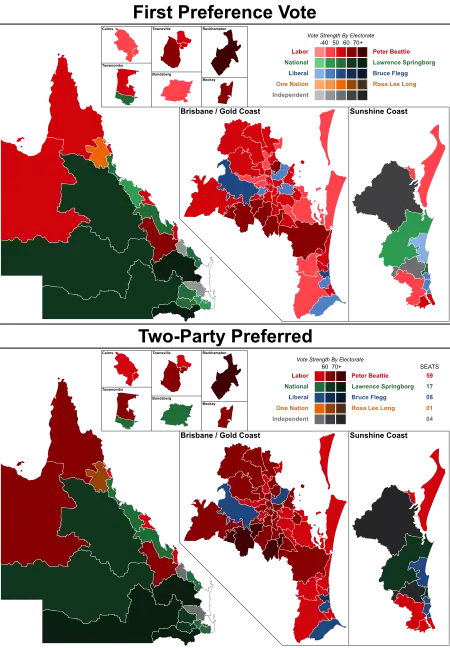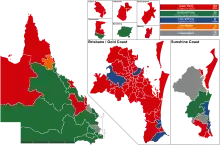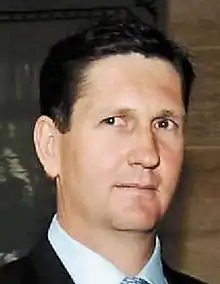2006 Queensland state election
An election was held in the Australian state of Queensland on 9 September 2006 to elect the 89 members of the state's Legislative Assembly, after being announced by Premier Peter Beattie on 15 August 2006.
| |||||||||||||||||||||||||||||||||||||||||||||||||
All 89 seats in the Legislative Assembly of Queensland 45 Assembly seats were needed for a majority | |||||||||||||||||||||||||||||||||||||||||||||||||
|---|---|---|---|---|---|---|---|---|---|---|---|---|---|---|---|---|---|---|---|---|---|---|---|---|---|---|---|---|---|---|---|---|---|---|---|---|---|---|---|---|---|---|---|---|---|---|---|---|---|
| Turnout | 90.47 ( | ||||||||||||||||||||||||||||||||||||||||||||||||
| |||||||||||||||||||||||||||||||||||||||||||||||||
 The top map shows the first party preference by electorate. The bottom map shows the final two-party preferred vote result by electorate. | |||||||||||||||||||||||||||||||||||||||||||||||||
| |||||||||||||||||||||||||||||||||||||||||||||||||
The election saw the incumbent Labor government led by Premier Peter Beattie defeat the National-Liberal Coalition led by Lawrence Springborg and Bruce Flegg respectively, and gain a fourth consecutive term in office. Beattie thus became the first Labor Premier of Queensland to win four consecutive elections since William Forgan Smith did so in the 1930s. Had Beattie served out his fourth term, he would have become the second-longest serving Queensland Premier, after Sir Joh Bjelke-Petersen. After the election, Springborg resigned as Opposition Leader, being replaced by Jeff Seeney.
Key dates
| Date | Event |
|---|---|
| 15 August 2006 | Writs were issued by the Governor to proceed with an election[1] |
| 19 August 2006 | Close of electoral rolls |
| 22 August 2006 | Close of nominations |
| 9 September 2006 | Polling day, between the hours of 8am and 6pm |
| 13 September 2006 | Beattie Ministry reconstituted |
| 22 September 2006 | Writ returned and results formally declared |
| 10 October 2006 | 52nd Parliament convened |
Results

The election result was disappointing for the Coalition. It failed to make significant gains from Labor, despite the fact that the Government had been in office for eight years and had been mired in a series of scandals in its third term. It also failed to make headway against the Independents which still held many safe rural conservative seats, winning back only Gympie. Recent instability in the Coalition, combined with a poor media performance by inexperienced Liberal leader Dr Bruce Flegg was seen as being responsible for the result. In addition, Premier Peter Beattie remained personally popular. With Labor’s huge majority largely intact, it was seen as being unlikely that the Coalition would be able to win the next election.
|
Queensland state election, 9 September 2006[2] | ||||||
|---|---|---|---|---|---|---|
| Enrolled voters | 2,484,479 | |||||
| Votes cast | 2,247,728 | Turnout | 90.47 | –0.97 | ||
| Informal votes | 43,657 | Informal | 2.08 | +0.09 | ||
| Summary of votes by party | ||||||
| Party | Primary votes | % | Swing | Seats | Change | |
| Labor | 1,032,617 | 46.92 | –0.09 | 59 | – 4 | |
| Liberal | 442,453 | 20.10 | +1.60 | 8 | + 3 | |
| Nationals | 392,124 | 17.82 | +0.86 | 17 | + 2 | |
| Greens | 175,798 | 7.99 | +1.23 | 0 | ± 0 | |
| Family First | 41,659 | 1.89 | +1.89 | 0 | ± 0 | |
| One Nation | 13,207 | 0.60 | –4.28 | 1 | ± 0 | |
| Independent | 103,022 | 4.68 | –1.15 | 4 | - 1 | |
| Total | 2,200,880 | 89 | ||||
| Two-party-preferred | ||||||
| Labor | 1,122,233(est)[3] | 55.0 | ||||
| Liberal | 916,816(est)[3] | 45.0 | ||||
| * The two-party preferred summary is an estimate by Antony Green using a methodology by Malcolm Mackerras. | ||||||
Mackerras pendulum
The following is a Mackerras pendulum for the election.
"Very safe" seats require a swing of more than 20 per cent to change, "safe" seats require a swing of between 10 and 20 per cent to change, "fairly safe" seats require a swing of between 6 and 10 per cent, while "marginal" seats require a swing of less than 6 per cent.
State of the parties before the election
Since April 2006, the ALP held 60 of the 89 seats in the Legislative Assembly, the Coalition 23 seats (16 National and seven Liberal), along with five Independents and one member of the One Nation Party. Thus to win an outright majority (45 seats), the Coalition would have needed to win an additional 22 seats from the ALP, the Independents or One Nation, assuming that they retained all of their own seats. This would have required a uniform swing against Labor of approximately 8% (such swings are very rare).
Sitting Labor member for Noosa, Cate Molloy, had resigned from the Labor Party following her disendorsement as a Labor candidate, which in turn followed her repudiation of the state government's plans to build a dam on the Mary River at Traveston. Molloy recontested the seat as an Independent.
Members who did not recontest their seats
A number of members of parliament retired at this election:
- Tom Barton: Waterford, ALP
- Darryl Briskey: Cleveland, ALP
- Dr Lesley Clark: Barron River, ALP
- Nita Cunningham: Bundaberg, ALP
- Jim Fouras: Ashgrove, ALP
- Don Livingstone: Ipswich West, ALP
- Tony McGrady: Mount Isa, ALP
- Gordon Nuttall: Sandgate, ALP
- Henry Palaszczuk: Inala, ALP
- Bob Quinn: Robina, Liberal
- Terry Sullivan: Stafford, ALP
- Marc Rowell: Hinchinbrook, Nationals
Issues
From mid-2005, after the revelation of the Jayant Patel scandal, the issue of health has become a focus of controversy, damaging to the Beattie government. After several inquiries and industrial disputes, a restructure of Queensland Health took place, and the state government is currently lobbying the federal government for more doctor training places in universities for Queensland.
Other issues of importance at the election included environmental management and land clearing, asbestos in state schools, the provision of transportation and infrastructure to rural and regional areas, and the management of South East Queensland's population growth.
Polling
| Primary vote | 2PP vote | ||||||
|---|---|---|---|---|---|---|---|
| Date | ALP | LIB | NAT | GRN | OTH | ALP | L/NP |
| 2006 election | 46.9% | 20.1% | 17.8% | 8.0% | 7.2% | 55.0% | 45.0% |
| 6–7 Sep 2006 | 48% | 21% | 17% | 4% | 10% | 55% | 45% |
| 25–28 Aug 2006 | 52% | 20% | 16% | 2% | 10% | 58% | 42% |
| Jul–Aug 2006 | 45% | 25% | 13% | 2% | 15% | 54% | 46% |
| Apr–Jun 2006 | 41% | 26% | 13% | 4% | 16% | 52% | 48% |
| Jan–Mar 2006 | 40% | 28% | 14% | 4% | 14% | 50% | 50% |
| Oct–Dec 2005 | 40% | 27% | 16% | 3% | 14% | 50% | 50% |
| Aug–Sep 2005 | 41% | 26% | 16% | 4% | 13% | 50% | 50% |
| Jul–Aug 2005 | 40% | 27% | 15% | 3% | 15% | 50% | 50% |
| Apr–Jun 2005 | 47% | 23% | 14% | 3% | 13% | 56% | 44% |
| Jan–Mar 2005 | 46% | 27% | 11% | 5% | 11% | 55% | 45% |
| Oct–Dec 2004 | 43% | 29% | 12% | 3% | 13% | 52% | 48% |
| 2004 election | 47.0% | 18.5% | 17.0% | 6.7% | 10.8% | 55.5% | 44.5% |
| 4-5 Feb 2004 | 50% | 18% | 15% | 5% | 12% | 59% | 41% |
Labor's high levels of support was maintained until mid-2005 when support for Labor slumped and the Coalition opened a minor lead on primary votes for the first time since 1996. However, this was eventually wiped out as Labor restored a huge lead in polls in the lead up to the election and the Coalition only managed a 0.5% swing. Even though some mid-term polls suggested a swing of up to 6% against Labor, a swing of over 8% was required for Labor to lose its majority.
Campaign
The campaign started unusually with Premier Peter Beattie denying a general election was about to be called, while residents in some Gold Coast electorates received direct mail from the ALP stating that the election had been called for September.
At a press conference on 16 August, Liberal leader Bruce Flegg stated that in the event that the Coalition won government, and the Liberal Party won more seats than the Nationals, Lawrence Springborg would still become Premier.[5] Other Liberal Party MPs such as Michael Caltabiano disagreed, as this ran contrary to the coalition agreement signed between the two parties, which stated that whichever party won the most seats would form government. The ALP used this to attack Coalition stability in media and advertising.
Flegg was subsequently asked to leave a shopping centre in the Redcliffe suburb of Kippa-Ring for failing to obtain permission to do a campaign walkthrough.[6] Flegg later denied that he had in fact been evicted.
On 22 August, Flegg took part in a media conference with Julie Bishop, federal Liberal Minister for Education, where he endorsed a Federal Government plan for the mandatory teaching of Australian history in schools. Responding to questions from journalists, he failed to identify the date of arrival of the Second Fleet (1790), or the person after whom Brisbane was named (noted astronomer and Governor of New South Wales Sir Thomas Brisbane).[7]
Two sad twists of fate impacted the 26-day campaign - on 30 August, opposition leader Lawrence Springborg took temporary leave from the campaign after the sudden death of his father-in-law, and National Party deputy leader Jeff Seeney and Liberal leader Bruce Flegg continued the campaign in his absence.[8] The death of TV personality Steve Irwin ("The Crocodile Hunter") on 4 September in an accident off Port Douglas, Queensland, took the media's focus away from the election in its final week.[9]
Current Treasurer Anna Bligh has stated the coalition's major election promises of wiping out stamp duty within five years, increasing the first home buyers grant by $3,000 and introducing a 10% per litre subsidy on ethanol-blended petrol will cost $2.4 billion and has blown the budget. Lawrence Springborg says all his election promises are costed and affordable, with costings to be released two days before the election.[10] So far these costings have not been released.
On Friday 8 September, the day before the election, Premier Beattie and Opposition Leader Springborg participated in a "great debate"[11] at the Brisbane Convention & Exhibition Centre, moderated by ABC journalist Chris O'Brien.
Although Newspoll and other published polls showed Labor well ahead on predicted two-party-preferred vote, Labor strategists feared that people would vote for the Coalition in a protest vote, expecting Beattie not to lose.[12] They adopted a strategy of denying Labor was in fact ahead.[13] The Roy Morgan poll suggested the Liberal vote had fallen, while the Greens had risen to 8%.[14]
Seats changing hands
| Seat | Pre-2006 | Swing | Post-2006 | ||||||
| Party | Member | Margin | Margin | Member | Party | ||||
| Bundaberg | Labor | Nita Cunningham | 5.3 | -6.3 | 1.0 | Jack Dempsey | National | ||
| Chatsworth¶ | Liberal | Michael Caltabiano | 2.5 | -3.3 | 0.8 | Chris Bombolas | Labor | ||
| Clayfield | Labor | Liddy Clark | 1.2 | -2.7 | 1.5 | Tim Nicholls | Liberal | ||
| Gaven¶ | National | Alex Douglas | 3.4 | -6.5 | 3.1 | Phil Gray | Labor | ||
| Gympie | Independent | Elisa Roberts | 10.1 | -25.6 | 15.5 | David Gibson | National | ||
| Kawana | Labor | Chris Cummins | 1.5 | -7.3 | 5.8 | Steve Dickson | Liberal | ||
| Noosa† | Independent | Cate Molloy | 8.7 | -9.7 | 1.0 | Glen Elmes | Liberal | ||
| Redcliffe¶ | Liberal | Terry Rogers | 1.3 | -6.7 | 5.4 | Lillian van Litsenburg | Labor | ||
¶The margins and swings in Chatsworth, Gaven and Redcliffe are relative to the by-election results.
†The margin for Noosa was notionally Labor, but sitting member Cate Molloy became an independent earlier in 2006. The post-election margin is National v. Labor.
See also
References
- Electoral Commission of Queensland (March 2007). Queensland Election 2006: Statistical Returns. p. 6. ISBN 0-7242-6857-X.
- Electoral Commission of Queensland. "Parliament of Queensland, Assembly election, 9 September 2006". Archived from the original on 16 May 2009. Retrieved 22 March 2009.
- Antony Green (2008). "2008 Queensland Redistribution: Analysis of Redistributed Boundaries based on 2006 Election Results" (PDF). Retrieved 22 October 2020.
- Green, Antony. "Totals for the 2006 Election". Queensland Election Archive. Retrieved 7 December 2014.
- "2006 Queensland. News: Springborg moves to defuse leadership tensions. Australian Broadcasting Corp". ABC. 16 August 2006. Archived from the original on 11 May 2011. Retrieved 9 June 2010.
- "2006 Queensland. News: Flegg denies shopping centre confrontation. Australian Broadcasting Corp". ABC. 18 August 2006. Archived from the original on 11 May 2011. Retrieved 9 June 2010.
- "Springborg leaves election campaign after father-in-law's death. 30/08/2006. ABC News Online". Abc.net.au. 30 August 2006. Archived from the original on 11 May 2011. Retrieved 9 June 2010.
- "Steve Irwin". The Poll Bludger. 4 September 2006. Archived from the original on 28 July 2008. Retrieved 27 January 2012.
- "2006 Queensland. News: Parties at odds over Coalition's costings. Australian Broadcasting Corp". ABC. 4 September 2006. Archived from the original on 11 May 2011. Retrieved 9 June 2010.
- Archived 16 November 2007 at the Wayback Machine
- Archived 16 November 2007 at the Wayback Machine
- "Labor 'needs a miracle' to take Liberal seats. 07/09/2006. ABC News Online". Abc.net.au. 7 September 2006. Archived from the original on 11 May 2011. Retrieved 9 June 2010.
- "[Roy Morgan Research] Morgan Poll". Roymorgan.com. Archived from the original on 10 June 2011. Retrieved 9 June 2010.
External links
- Election analysis by Antony Green of the ABC
.jpg.webp)
